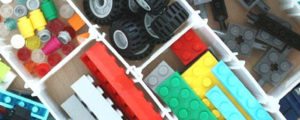When it’s time for a building challenge, sometimes kids get hung up on appearance, or maybe they come up with features that are powered entirely by the imagination.
Nothing wrong with these approaches, but a LEGO car racing challenge puts the focus squarely on those engineering skills. That is, they’ll be building the car from the ground up and testing how they perform. They’ll be experiencing the relationship between design and performance — and that creates the perfect STEM activity that also engages their minds.
Set up a LEGO car race as an activity for family night or a way to pass the time when friends or cousins are visiting. Just allow your kids to design their own cars; as the blog Little Bins for Little Hands points out, you can build alongside them and turn your solutions into a learning moment for them.
Why not make this a birthday party activity? Hand out kits that the partygoers can snap together, race and take home as a (sugar-free) party favor. Whatever you do, it’s sure to engage a wide age range of kids.

Here are two easy ways to test those LEGO construction cars:
Derby-style races
Build an elevated plank from an old folding table or a sheet of plywood, and release the cars from the top.
- Add weights by taping on quarters and see what happens. What if you move the quarter to the front of the car, or the back? What happens if you add a second or third quarter?
- How about when you change the aerodynamics of the car? Does it help the car go faster when it has a pointed front versus a squared-off front? How can you add creative touches, such as a seat for your favorite LEGO figure, without hampering your car’s performance?
- Talk about wheel size and smoothness. Do knobby wheels perform better than smooth wheels? What happens when you switch out smaller wheels for larger? Does adding more wheels to the axles help with speed, or slow it down? (If you really want to get the cars to zoom down-track, they do make special axles and wheels designed for racing LEGO cars.)
Balloon race
Instead of a gravity-powered race, how about one that’s powered by balloons releasing air? When you build the car, just leave a little window at the top to accommodate the neck of a balloon. Then, blow it up, and after the ready-set-go, let ’em rip!
Like good engineers, review the design and see where it can use improvement. What problems are the cars running into? How can we rework the design to fix these problems? (Hint: The spent balloon can flop down and get caught under the wheels.)
- Does adding weights help?
- Do narrow cars perform better than wider cars?
- What happens when you race the cars on different surfaces?
Like real-life engineers, kids participating in these challenges get a chance to review their designs and make them even better!